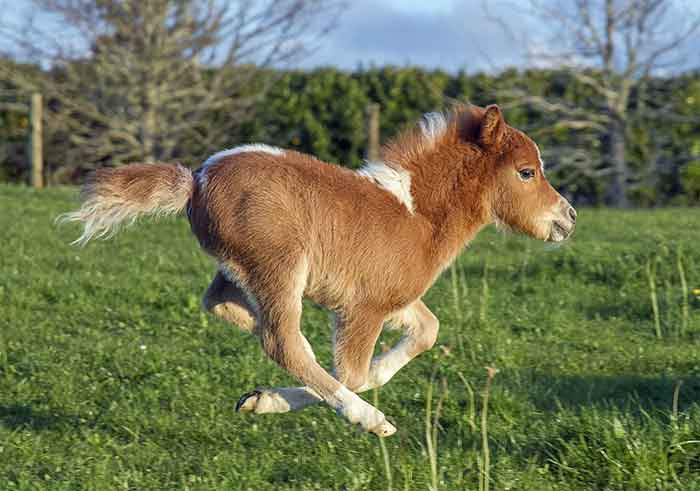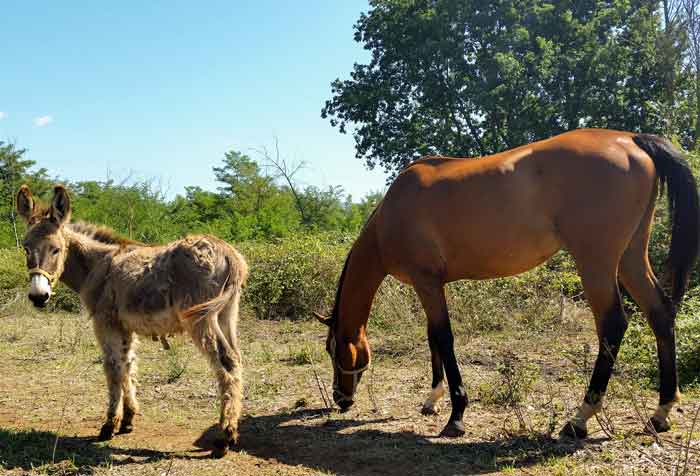Some horse owners have a hard time teaching the horse how to jump. This can be tricky if the horse is afraid or too stubborn.
Here are our best tips on how to get your horse to jump.
Table of Contents
First Thing To Check When Horses Won’t Jump
First, we need to know whether this is a new thing or something the horse has never been good at.
If your horse has never been a good jumper you can skip to the next section, but if this is a new development it may be because jumping is painful to the horse, at the moment.
The horse might be in pain
If it used to jump but suddenly started to refuse you are probably experiencing this because the horse is in pain.
If the horse has a sore hoof or one leg has been hurt in some way, it might refuse to jump because it knows that it will hurt. It’s no fun jumping when you have a sore foot.
This might be because it has worn out a horseshoe, a hurt foot, or maybe there’s a crack in the hoof that is causing irritation to the horse.
You need to take a good look at whether the horse is limping or not. If that’s the case we have found the root of the problem and you need to have it checked. If it’s not limping you might need to watch its body language and check whether it behaves differently than it used to in other situations as well.
You need to examine the hooves and the feet and maybe have a vet look at it if you suspect this is the cause. It can be dangerous for the horse to keep going with a sore foot or a crack in the hoof that is causing pain.
You also need to check the saddle. It might not fit as well as you think and it’s typically where the horse is feeling pain. Make sure the saddle fits correctly and that you have the right saddle size for your horse.
Consult a vet if suspect it is in pain
If you have tried to start all over and let the horse experience some success on the lowest pole you need to make sure it’s healthy. It might refuse to jump for reasons you cannot see that are related to pain.
It’s not always easy to see when a horse is in pain.
So, you should have the hooves checked and have a full-body scan done by a professional.
6 Reasons Horses Refuses To Jump
If your horse does know how to jump but suddenly refuses to jump we need to take action immediately.
If the horse suddenly turns around the obstacle instead of jumping over it you should turn the horse around 180 degrees immediately in order to try again.
Don’t let it “win” or stay in the mindset of refusal. There can be several reasons why it refuses to jump:
1) The horse suddenly experiences fear
You need to overcome the fear by going back to the cavaletti (or obstacle) and try again. You might even start out with a lower obstacle in order to build up some confidence.
This may happen if the horse for some reason jumps too late or too early and it pops and jumps up too vertically. This can result in a jump that won’t have any forward momentum and the horse might be surprised.
Make sure to try the jump again immediately and maybe add a little more speed so you force the horse over the cavaletti.
2) It gets stubborn
If the horse just gets stubborn and refuses to listen to you it’s equally important that you force it over the obstacle immediately.
Don’t take a big round, just get back to the jump and make sure the horse follows the track and continues over the jump.
3) You need to add more height
You might need at least 25” (64 centimeters) height before the horse actually jumps.
If the horse has shown you that it knows how to jump it might get bored and lose interest if the task seems boring.
It can walk over smaller obstacles and it might do so because it’s too small of a challenge. So you might be going TOO slow if it shows no interest at this point.
Make sure to find the balance between moving forward too fast on the learning curve versus letting the horse get bored. It the horse gets lazy you might need to add some more challenge to the next jump and let her feel your enthusiasm. Your mood can quickly affect the horse to show more enthusiasm.
4) It needs more speed
Make sure you add enough speed when you start to raise the bar a little bit.
You need a little more speed to get over the obstacle when the horse needs to actually jump in order to get over the pole. It’s also important to let it have enough distance in order to calculate the jump just right. This typically comes naturally to the horse and it will learn it quickly.
You shouldn’t trot toward an obstacle that is taller than 25”. Let the horse canter and the jump will typically come more natural.
If you are going too slow the horse might avoid the jump because it’s not confident that it can make it to the other side.
5) It might just need a break
Horses get tired much quicker when you try to teach them new tricks and stuff. You might be dealing with a tired horse even though it will normally keep going for hours.
Try and catch a snack and some water and try again.
You need to know the horse well in order to detect this and if all other options seem gone it might just be tired.
You both need to practice your timing to make sure you can make the jump. It takes time and the horse will typically get this much faster than the rider. You might feel like the horse is not getting it because you get nervous but here you need to trust the horse.
Let it show you that it knows how to do it by following its movements. Don’t start catching the horse in order to direct it if it shows a confidence that it will make a fine jump.
If the horse starts to miss the timing it’s more likely that it is getting tired. Again, take a break and reward yourself with some quality time and a snack. It will love you for it and you will both have a better time if you take enough breaks.
The horse (and yourself) tend to get more tired when you are learning new stuff.
6) If nothing works…
Try to have an experienced rider test your horse. He or she might show more confidence and be able to let your horse overcome the fear or anxiety.
It’s a cheap way to find out whether it’s you or the horse. If the more experienced rider can have the horse do some jumping you will know for sure that the issue is not related to pain.
And you will also be able to learn a thing or two about how to manage the horse. It’s always good with a second opinion when we get stuck with our horses.
When Is A Horse Old Enough To Jump?
Horses can start jumping over smaller obstacles when they are around 3 years old. When they turn 4 they can start practicing some more serious jumping education and bigger challenges.
This doesn’t mean that you cannot start playing around with a few jumps before the age of 3. Each horse has its own personality and temper and if you feel like the horse is interested in jumping you might as well start out early.
Just make sure you don’t stress it or forces it too quickly.
Horses at the age of 2 (or less) should have plenty of time to just fool around and not feel like they are being taught new things all the time. They can start jumping over smaller logs if they show an interest.
4 Steps To Teaching A Horse To Jump
Your horse may not know how to jump.
Many horse owners wrongfully assume that all horses know how to jump by nature. This is not the case.
Most horses need to learn how to jump especially when you’re put a rider on its back. It doesn’t have to take a lot of practice to get the first jumps right but it needs to learn how to do it.
This is how you do it.
1) Get familiar with the cavaletti
It’s important to let the horse get familiar with the different parts of the cavaletti. It should get used to the different smells around the obstacle as well as how they look.
Make sure to take some rounds where you go all the way around obstacles from each side. This way the horse will know exactly what’s on the other side and what the obstacle looks like from all the sides.
If possible, break down the obstacle into lower sections in order to have the horse walking over the poles, etc. This will also help to make the horse more comfortable around the items of the obstacle. It might look frightening to it at first because it has several strong colors.
Make sure to praise the horse and let it know how well it did by walking over or smelling the obstacle.
You should also do this at a trot and canter so the horse gets even more familiar with the obstacles.
2) Walk over the lowest possible cavaletti
Now it’s time to start building up the height from the very lowest position of the pole. The pole can typically be mounted just a few inches above the ground. This should be easy for the horse and there should be no problems with this.
If the horse is starting to feel uncomfortable at this stage, you should call it a day and continue another day. This is always a good option whenever you feel that the horse is getting tired.
It might also be you getting tired. If you feel like you are starting to stress out the horse and your teamwork is starting to suffer, it is time to stop for the day.
Never push it through too many steps in one day.
Come back the next day and start by doing the same as you did the previous day. This will give the horse some self-confidence as you slowly build up new tricks on top of the things it already knows.
Again, you should finish off this step by doing the same thing with trotting and cantering. This gives your horse more experience and teaches it to get comfortable with the obstacle.
3) Practice a little more speed
Now that your horse knows how to walk, trot and canter over the very low pole, it’s time to add a little more speed.
The horse should be comfortable with the pole now and by telling it to add a little speed you can get closer to an actual jump.
The first time the two of you might not coordinate the steps well and it might not work. So make sure you don’t speed up too quickly. If you are going too fast you always shorten the stride to get the distance right to the obstacle.
If it starts to dodge you need to show some grace and stop for a moment and speak some comforting words. It needs to feel secure and it needs to know that you are in full control at all times. So you also need to make sure that you are never pushing your own limits at this point.
When you and your horse are ready you should try to do a tiny jump. Just add enough speed until it feels right.
4) Start adding some height
Now you both know how to jump and it’s time to start building up the cavaletti.
It’s not uncommon for a horse to start out with a brave attitude and then suddenly realize what it is doing and start getting nervous. So remember to have plenty of time and be ready to start all over from the tiny obstacles once in a while.
Congratulations. You are now officially starting to get it and your horse has done its first couple of jumps.
Jumping is fun and it’s a great exercise for any horse rider even if you never intend to use it for anything. The fact that you are both comfortable when jumping over obstacles gives you more confidence and if you would have to make a jump to avoid an unforeseen obstacle you will be ready for it.
It’s now more safe for you and your horse when you are riding.
Work with a trainer
If you don’t feel like the method above works for you it can be a great idea to take a day out to spend with an experienced horse trainer. He/she will be able to take a few rounds with the horse and get it comfortable around the cavaletti.
It’s also a great experience for you as the rider as you get to see how a professional trains a horse.
It’s great to get some tips once in a while and it’s not that expensive to get a lesson or two.
You can typically find a local trainer if you contact a local riding school. They might be able to take a look at you with your horse and get you some good tricks and tips.
It’s always important to have a second opinion when you can’t figure out what’s going on.






